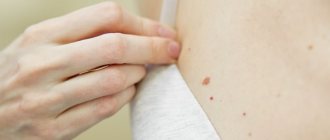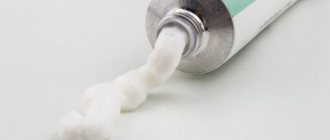Stretch marks - the whole truth
What it is
Stretch marks are also called stretch marks. They appear in any area of the body, but most often occur in places where there is a large amount of fat. Most common places
: chest, stomach, armpits, shoulders, thighs, back and buttocks.
Stretch marks look like stripes on the skin, and their color changes over time. “Fresh” stretch marks are pinkish-red in color, the skin on them is slightly convex. Gradually, the striae increase in length and width, become bluish-purple, and eventually become discolored. This happens because at first there are still blood vessels inside the stretch marks, which is why the stretch marks initially have such a bright color. Then the blood supply at the site of the stretch marks stops, the vessels become empty, the resulting skin defect is filled with connective tissue and the stretch marks become white. Since there is no pigment in the connective tissue, stretch marks remain white even when exposed to sunlight. Moreover, against the background of tanned skin they become more noticeable.
Why do they occur?
It seems that the reason for the appearance of stretch marks during pregnancy is clear at first glance: the expectant mother’s belly grows, the skin stretches, and stretch marks form. Why then do they not occur in all expectant mothers? And is their appearance related to weight gain? After all, it has been noted, for example, that the likelihood of stretch marks does not depend in any way on the size of the abdomen during pregnancy.
Stretch marks may appear in a woman with a small belly, while a woman expecting twins will not have this problem.
Why is this happening? Several factors are at work here. Yes, indeed, one of the reasons for the appearance of stretch marks is weight gain, but what is important is not so much the number of kilograms gained, but how quickly the woman gained them: the faster the expectant mother gains weight, the higher the risk of stretch marks. This is why even with a slight weight gain, stretch marks can appear. The second reason for the appearance of stretch marks is hormonal imbalance. During pregnancy, the amount of estrogen and cortisol decreases, resulting in a disruption in the synthesis of skin proteins and connective tissue - collagen and elastin. Namely, with the help of these proteins, our skin can stretch well and restore its elasticity.
If there is not enough collagen and elastin, then the skin becomes fragile and thins out faster, in the end, it tears in some areas, and then scar connective tissue forms in places of tears
.
But here’s how the expectant mother’s body will behave during pregnancy: whether there will be sudden changes in weight and hormonal imbalance (which means whether stretch marks will appear or not is impossible to predict).
What to do?
Let’s say right away that the treatment is 100% effective
and there is no prevention of stretch marks. For example, most creams, lotions, and gels for the prevention of stretch marks simply contain moisturizing components and help soften the skin, but do not affect the balance of hormones. Consequently, these remedies cannot prevent the appearance of stretch marks if hormonal imbalances have occurred. And after childbirth, various laser procedures, peelings and resurfacing will not get rid of stretch marks completely, they will simply make them more invisible.
But this does not mean that you should give up and do nothing. You can do a lot of things: even if you don’t achieve 100% effect, there will still be benefits.
– Watch your diet
and avoid sudden weight fluctuations. Don't forget to eat protein foods - protein, along with zinc and vitamin C, stimulates the production of collagen, which gives the skin elasticity. If you don’t want meat yet, include fish, dairy products and legumes in your diet - these are also sources of healthy protein.
– Avoid sweets
– sugar inhibits collagen renewal, the skin loses elasticity and water, becomes dry, sluggish, and its elasticity decreases.
– From the first days of pregnancy, constantly nourish
and
moisturize your skin
.
,
use creams, gels, lotions with collagen, elastin, as well as vitamins C and E. The main thing is that these drugs must be approved for use during pregnancy. Before buying this or that product, carefully read the instructions and composition of the drug. Find out the mechanism of action of biologically active substances of a cosmetic product from a sales consultant. If you have any doubts, consult your obstetrician-gynecologist. Look into your wallet and make a choice.
– If finances allow, do salon treatments
to moisturize the body, those allowed during pregnancy (algae wraps, for example), if not, limit yourself to regular skin moisturizing, it is also effective.
– Take contrast showers
: it tones and strengthens the skin, and problem areas receive the blood flow they need. You can massage individual areas of the body alternately with a cold and warm stream. Just don't point the stream directly at your stomach.
– After a shower, do not wipe your body dry, but simply pat it dry with a towel. You can do light pinch self-massage
using moisturizing creams or natural vegetable oils (for example, olive or flaxseed). Massage helps remove excess fluid and activates the work of blood vessels - they quickly distribute nutrients throughout the body. Important: when massaging, go around the abdomen and chest, massage only the sides, hips and legs.
– Swim
: the contrast in water and air temperature, active physical activity also help prevent stretch marks.
Wear special bras during pregnancy
, they will support enlarged breasts and prevent the skin from overstretching.
Even if stretch marks appear, don’t be upset. It has been noticed that if you immediately begin a set of preventive measures (moisturizing the skin, proper nutrition, water treatments), then stretch marks often do not spread further. And if you start prevention from the first days of pregnancy, they may not appear at all.
REMINDER for mothers
Start attacking stretch marks as early as possible: the younger they are, the less money and time it will take to eliminate them.
- Watch your diet and try not to gain weight suddenly.
- Moisturize and nourish the skin daily, not only of the abdomen and chest, but also of the thighs, buttocks, and legs.
- Lead an active lifestyle: walk in the fresh air, play sports, swim.
- Take a contrast shower, do self-massage.
- Wear the right underwear: a maternity bra is especially necessary for expectant mothers with large breasts
On a note:
It is impossible to predict the appearance of stretch marks. Even if during the last pregnancy there were no stretch marks or, on the contrary, there were stretch marks, there is no guarantee that the situation will repeat in the next pregnancy
You can make your own composition for stretch marks.
Here are the oils that will suit you:
- Jojoba oil is the most effective remedy: it is used for the prevention and elimination of skin stretch marks during and after pregnancy, as well as for weight gain and sudden weight loss.
- Rosewood essential oil helps improve skin elasticity and also helps resolve small scars.
- Almond oil is especially effective for caring for areas of the body where skin elasticity is reduced.
- Grape seed oil has a strong regenerating effect and increases skin elasticity.
- Peach oil has a regenerating, softening effect on the skin, restores elasticity, and rejuvenates sagging skin.
You can use mixtures of these oils in any combination, for example: jojoba + almond oil, or jojoba + grape seed oil.
Before using any oil, read the instructions and pay attention to contraindications. Try the oil or composition on a small area of skin and monitor the reaction throughout the day. If discomfort or allergies occur, discard this product.
Do stretch marks tan?
This question is asked by many pregnant and non-pregnant women. Because everyone wants to disguise these flaws and look their best. But we will disappoint you: stretch marks (striae) cannot tan. The explanation is that in the connective tissue from which scars are formed, there is no pigment called “melanin”.
You may also notice that after spending many hours in the sun, the stretch marks become even more noticeable because the underlying skin has become darker, but the stretch marks remain white or light.
Homemade scrub recipe
The epithelium becomes keratinized over time, so it must be peeled off periodically. Homemade scrubs are created for this purpose. Their advantage is that you have complete control over the composition of the product and know that nothing harmful to you or your baby will get into it.
Take 100 ml of cream (the fattier the better; give preference to homemade rather than store-bought), pour in 3-4 drops of vitamin A or E, add sea salt until the consistency becomes thick. The finished scrub should be applied (not all of it!) onto a massage glove or simply taken with your fingers and treated the skin on the legs, chest and abdomen. You can leave the product on the skin for a little while (up to 5 minutes) and rinse with a warm shower. Next, you can apply vegetable oil, baby cream or stretch mark cream to the skin to moisturize and nourish it.
Oil massage at home
Some ladies do not trust the remedies for stretch marks that are sold in stores. Therefore, you can use home remedies. You can use oils for massage:
- sea buckthorn
- olive
- almond
- peach, etc.
They contain vitamin E, which is known to have a beneficial effect on the skin's ability to stretch without tearing. The oil can be slightly warmed up (for example, placed on a radiator) and rubbed into problem areas after you have taken a bath. You can also rub in the oils after the scrub, the recipe for which is described above.
Some beauty and skin experts advise adding essential oils to the base oils (named above) at your discretion. But we do not recommend such experiments. Because you cannot predict your body’s reaction to the oil and its effect on the fetus. Serious allergic reactions are possible, even angioedema, the outcome of which is often fatal. If you were a fan of aromatherapy before conception, you should put this hobby aside while you are pregnant. Safety comes first!
Gymnastics for pregnant women
Before performing any exercises or practices, you should consult your obstetrician-gynecologist. Each case is individual. What suited your neighbor who gave birth may not suit you at all. An adequate doctor (in the absence of serious pathologies) will help you choose a suitable sports complex. Complete passivity is recommended in extremely rare cases when the pregnant woman and the unborn baby have serious problems.
Remember that activity should be different in all trimesters. The reason is that some of the exercises that can be done in the first three months later become uncomfortable and even dangerous. Pregnant women should not do abdominal exercises, jumping, and weight training equipment is not recommended.
If you experience discomfort while doing exercises, or your pulse cannot “calm down,” then stop exercising immediately. Don’t rush to do all the exercises at once and in large quantities. If you were quite passive before conception, then you need to start with minimal loads.
Positional gymnastics for pregnant women
These exercises help prepare a woman's muscles for the process of childbirth, and will also help you feel more comfortable during childbirth by training specific muscles.
- “cat” pose: stand on all fours, round your back, lowering your head as low as possible, and then arch your back, raising your head while looking up (do everything smoothly and while breathing)
- “butterfly” pose: sit on the floor, pull your legs towards you on the floor and put your feet together (knees bent), put your hands on your knees. Use your palms to gently press on your knees so that the inner thighs stretch. Do not apply pressure to the point of pain, there should only be tension.
- twists: sit or stand; turn the body in one direction and the other, opening your arms in the same direction, while the pelvis does not rotate, it “looks” forward
- Kegel exercises: good for the perineal muscles; try to tense your muscles as if you want to block the flow of urine, and then relax them.
Fitball for pregnant women
This technique is no less effective than the one described above. It just has a different technique at its core. In the first 3 months of pregnancy, minimize stress. If you did not engage in dancing, yoga, sports or physical education before conception, start classes only from the 4th month of pregnancy. We will not describe exercises for the arms here, because stretch marks on them are extremely rare. Let's start with chest exercises .
- We sit on the floor, folding our legs in Turkish style, and take a fitball. Our arms are bent, elbows “look” to the sides. We begin to press the fitball with our palms and do 10-15 repetitions. Breathing should be smooth, without delays
- We sit on the ball and hold dumbbells in our hands. Bend your arms at an angle of 90˚ in front of your chest at the same level. We don’t extend our arms, but take them to the sides, and then bring them together again. As in the previous exercise, do 10 to 15 repetitions
Exercises for legs and buttocks:
- lie on your back, bend your right leg and place your foot on the ball. We also bend the left one and place it on the floor. We straighten our right leg and roll the ball forward, and then bend it again, returning it to the starting position. You can also make circular movements with your foot. Reps per leg: 6 to 8
- lie on your back again; release the left foot from the ball; We begin to use it as if to turn a bicycle pedal: first in one direction, then in the other. Next, we do the same with our right foot. 6 to 8 repetitions are also recommended.
- again we lie on our backs; lift and bend the right leg at the knee so that the shin is parallel to the floor. We rotate our feet in one direction, then in the other. 6-8 repetitions










